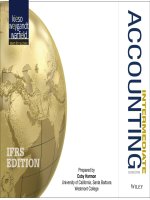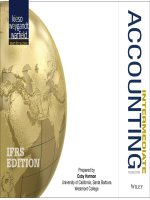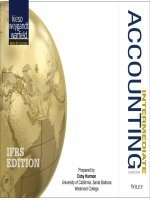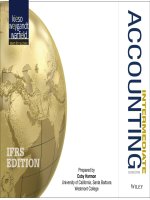Lecture Accounting principles (8th edition) – Chapter 20: Job order costing
Bạn đang xem bản rút gọn của tài liệu. Xem và tải ngay bản đầy đủ của tài liệu tại đây (1.33 MB, 58 trang )
Chapter
20-1
CHAPTER 20
JOB ORDER COST
ACCOUNTING
Accounting Principles, Eighth Edition
Chapter
20-2
Study Objectives
Study Objectives
1.
Explain the characteristics and purposes of cost accounting.
2.
Describe the flow of costs in a job order cost accounting system.
3.
Explain the nature and importance of a job cost sheet.
4.
Indicate how the predetermined overhead rate is determined and used.
Chapter
20-3
Study Objectives
Study Objectives
Chapter
20-4
5.
Prepare entries for jobs completed and sold.
6.
Distinguish between under and over applied
manufacturing overhead.
Preview of Chapter
Preview of Chapter
Accurate product costing is critical to a company’s success
For accurate bids on new jobs
For determining potential
profitability of new jobs
For identifying profitability of
completed jobs
Chapter
20-5
Job Order Cost Accounting
Job Order Cost Accounting
Cost
Cost
Accounting
Accounting
Systems
Systems
Job Order Cost
System
Process Cost
System
Chapter
20-6
Job
JobOrder
Order
Cost
Cost Flow
Flow
Accumulating
Manufacturing Costs
Assigning
Manufacturing Costs
to Work in Process
Assigning Costs to
Finished Goods
Assigning Costs to
Cost of Goods Sold
Summary
Reporting
ReportingJob
Job
Cost
CostData
Data
Cost of goods
manufactured
schedule
Income statement
presentation
Under-or
overapplied
manufacturing
overhead
Cost Accounting Systems
Cost Accounting Systems
Cost accounting involves:
Measuring,
Recording, and
Recording,
Reporting of product costs
Consists of the various manufacturing costs that are fully integrated
into the general ledger system.
An important feature is the use of a perpetual inventory system
to provide immediate, uptodate information on
the cost of a product.
Chapter
20-7
LO 1: Explain the characteristics and purposes of cost accounting.
Cost Accounting Systems
Cost Accounting Systems
There are two basic types of cost accounting systems.
Chapter
20-8
LO 1: Explain the characteristics and purposes of cost accounting.
Job Order Cost System
Job Order Cost System
Costs are assigned to each job or batch
A job may be for a specific order or inventory
A key feature:
Each job or batch has its own
distinguishing characteristics
The objective: to compute the cost per job
Measures costs for each job completed – not for set time periods
Chapter
20-9
LO 1: Explain the characteristics and purposes of cost accounting.
Job Order Cost System
Job Order Cost System
Chapter
20-10
LO 1: Explain the characteristics and purposes of cost accounting.
Process Cost System
Process Cost System
Used when a large volume of similar products are manufactured
Cereal, Automobiles, Compact Discs, Paint
Costs are accumulated for a specific time period –
A week or a month
Costs are assigned to departments or processes for a set period of
time
Chapter
20-11
LO 1 Explain the characteristics and purposes of cost accounting.
Process Cost System
Process Cost System
Chapter
20-12
LO 1 Explain the characteristics and purposes of cost accounting.
Cost Accounting Systems
Cost Accounting Systems
Review Question
Cost accounting involves the measuring, recording, and
reporting of:
a.
Product costs.
Product costs
b. Future costs.
c. Manufacturing processes.
d. Managerial accounting decisions.
Chapter
20-13
LO 1 Explain the characteristics and purposes of cost accounting.
Job Order Cost Flows
Job Order Cost Flows
The cost flow parallels the physical flow of the
materials as they are converted into finished goods
Manufacturing costs are assigned to Work in Process
Cost of completed jobs is transferred to Finished Goods
When units are sold, the cost is transferred to Cost of Goods Sold
Chapter
20-14
LO 2 Describe the flow of costs in a job order cost accounting system.
Job Order Cost Flows Overview
Job Order Cost Flows Overview
Chapter
20-15
LO 2 Describe the flow of costs in a job order cost accounting system.
Job Order Cost System
Job Order Cost System
Chapter
20-16
LO 2 Describe the flow of costs in a job order cost accounting system.
Job Order Cost Flow
Job Order Cost Flow
Two Major Steps in Flows of Costs
Accumulate the manufacturing costs incurred
Raw Materials
Factory Labor
Manufacturing Overhead
Assign the accumulated costs to the work done
Chapter
20-17
LO 2 Describe the flow of costs in a job order cost accounting system.
Accumulating Manufacturing Cost
Accumulating Manufacturing Cost
Raw Materials Costs
Raw Materials are debited to Raw Materials Inventory when purchased.
At this point, the cost of materials are not assigned to specific jobs or orders.
Example:
On January 4, Wallace Manufacturing Company purchases 2,000 handles at $5 per unit ($10,000) and 800 modules
at $40 per unit ($32,000) for a total cost of $42,000.
Chapter
20-18
LO 2 Explain the flow of costs in a job order cost accounting system.
Accumulating Manufacturing Cost
Accumulating Manufacturing Cost
Raw Materials Inventory
A General Ledger Account
is
A Control Account that summarizes the
detailed data regarding specific
inventory accounts in the Subsidiary
Ledger
Chapter
20-19
LO 2 Explain the flow of costs in a job order cost accounting system.
Accumulating Manufacturing Cost
Accumulating Manufacturing Cost
Raw Materials Costs Continued
The subsidiary ledger consists of individual records for each item of raw materials
May be accounts or manually/mechanically prepared cards
May be kept as computer data files
The records are referred to as materials inventory records or stores ledger cards
Chapter
20-20
LO 2 Explain the flow of costs in a job order cost accounting system.
Accumulating Manufacturing Cost
Accumulating Manufacturing Cost
Raw Materials Costs Continued
Postings are made daily to the
subsidiary ledger
After all postings, the sum of the
balances in the raw materials subsidiary
ledger equals the balance in the Raw
Materials Inventory control account
Chapter
20-21
LO 2: Explain the flow of costs in a job order cost accounting system.
Accumulating Manufacturing Cost
Accumulating Manufacturing Cost
Factory Labor Costs
Procedures for accumulating factory labor costs similar to those for
computing the payroll for a merchandising company
Consists of
Gross earnings of factory workers
Employer payroll taxes on such earnings, and
Fringe benefits incurred by the employer
Chapter
20-22
LO 2: Explain the flow of costs in a job order cost accounting system.
Accumulating Manufacturing Cost
Accumulating Manufacturing Cost
Factory Labor Costs Continued
Debited to Factory Labor when incurred
Example:
Wallace Manufacturing incurs $32,000 of factory labor costs, of which $27,000 relates to wages
payable and $5,000 relates to payroll taxes payable in January.
Chapter
20-23
LO 2: Explain the flow of costs in a job order cost accounting systems.
Accumulating Manufacturing Cost
Accumulating Manufacturing Cost
Manufacturing Overhead Costs
Many types of overhead costs
For example, machinery repairs, indirect materials, and indirect labor
Debit to Manufacturing Overhead
Daily as incurred or
Periodically through adjusting entries
Manufacturing overhead is a control account
Subsidiary ledger consists of individual accounts for
of cost
Chapter
20-24
each type
LO 2 Explain the flow of costs in a job order cost accounting system.
Accumulating Manufacturing Cost
Accumulating Manufacturing Cost
Manufacturing Overhead Costs Continued
Example:
The following is a summary entry to record the totals from multiple transactions that occurred
during January for the Wallace Manufacturing Company.
Chapter
20-25
LO 2 Explain the flow of costs in a job order cost accounting system.









